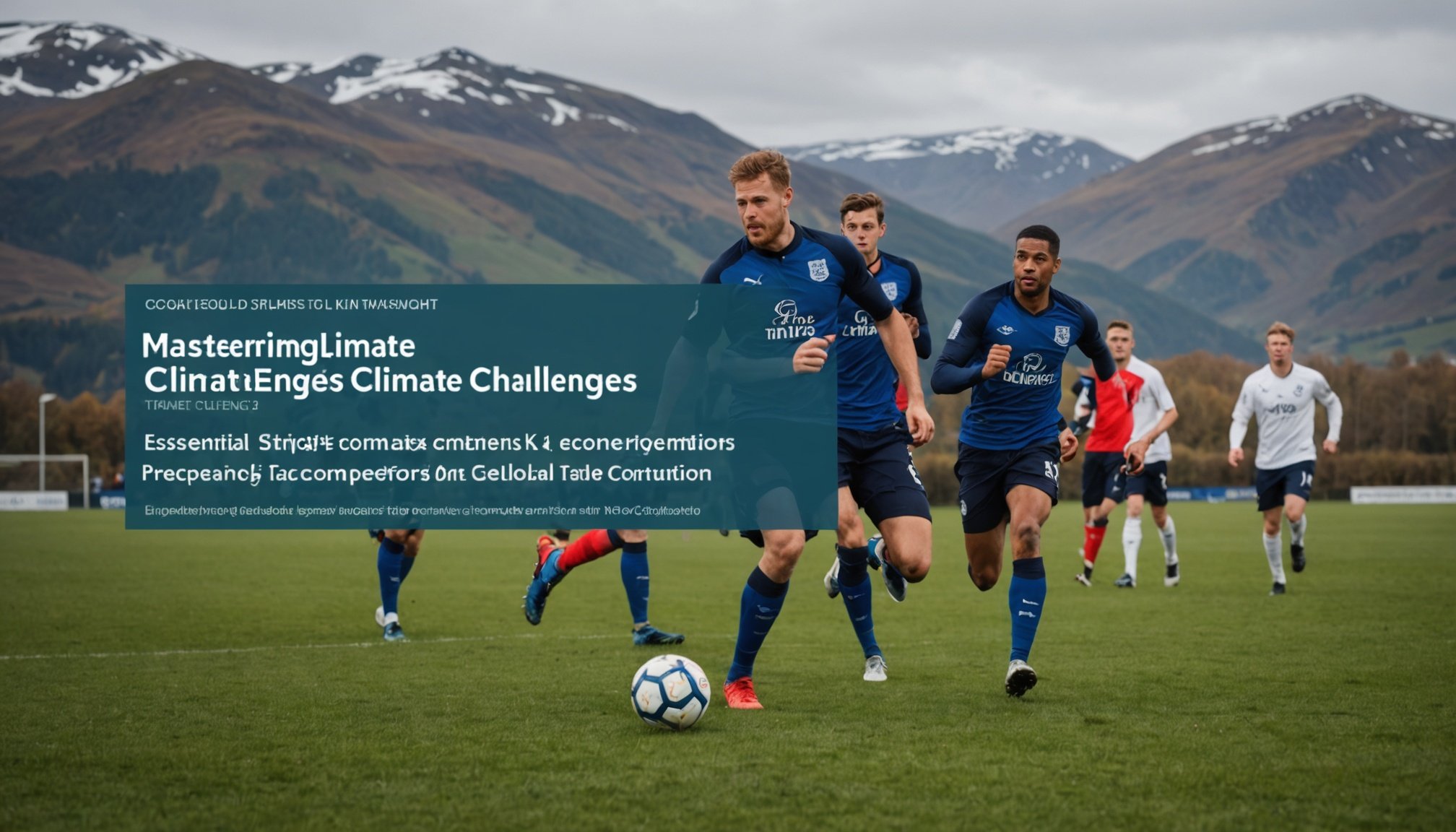Mastering Climate Challenges: Essential Strategies for UK Sports Teams Preparing for Global Competitions
As the world grapples with the escalating impacts of climate change, sports teams, particularly those at the elite level, are facing unprecedented challenges. For UK sports teams preparing for global competitions, adapting to these climate-related issues is crucial for maintaining high performance, ensuring athlete health, and mitigating risks associated with environmental changes.
Understanding the Climate Challenges
Climate change is not just an environmental issue; it has significant implications for sports. Rising temperatures, increased frequency of extreme weather events, and changes in precipitation patterns can all impact the way sports are played, trained for, and managed.
Have you seen this : Enhancing Court Surfaces: A Guide for UK Tennis Clubs to Minimize Player Injuries
Impact on Training and Competitions
- Heat Stress: Higher temperatures can lead to heat stress, a major concern for athletes, especially during intense training sessions and competitions. Coaches and support staff must be aware of the signs of heat stress and implement strategies to prevent it, such as scheduling training during cooler parts of the day and ensuring adequate hydration.
- Weather Extremes: Unpredictable weather conditions can disrupt training schedules and competitions. For instance, floods or droughts can render training facilities unusable, while extreme winds or storms can pose safety risks during outdoor events.
- Travel and Logistics: Climate change can also affect travel and logistics. For example, increased frequency of natural disasters can disrupt air travel, and changing weather patterns can impact the condition of sports facilities.
Innovative Solutions for Elite Sport
To address these challenges, UK sports teams are turning to innovative solutions that combine technology, sustainable practices, and strategic planning.
Sustainable Facilities and Practices
- Energy Efficiency: Investing in energy-efficient facilities is a key strategy. For example, using solar panels and wind turbines to power sports facilities can reduce carbon footprint and dependency on non-renewable energy sources.
- Water Management: Effective water management is critical, especially in regions experiencing drought or water scarcity. Collecting and purifying rainwater, as seen in the Floating Farm project in Rotterdam, can be a model for sports facilities to reduce their water consumption[1].
Technological Advancements
- Climate-Resilient Infrastructure: Building climate-resilient infrastructure is essential. This includes designing facilities that can withstand extreme weather conditions and incorporating materials that are resistant to heat and moisture.
- Data Analytics: Utilizing data analytics to predict and prepare for climate-related disruptions can be highly beneficial. Advanced weather forecasting and climate modeling can help teams anticipate and adapt to changing conditions.
Mental and Physical Health of Athletes
The mental and physical health of athletes is a top priority, and climate change poses unique challenges in this area.
Topic to read : Essential Elements for Launching a Thriving Youth Sports Initiative in the UK
Mental Health Impacts
- Stress and Anxiety: Climate-related disruptions can cause significant stress and anxiety for athletes. Coaches and support staff need to be trained in exercise psychology to provide the necessary mental support.
- “Athletes are not just physical performers; they are also mental athletes. The pressure to perform under changing environmental conditions can be immense,” notes Dr. Jane Smith, a leading sports psychologist.
Physical Health Considerations
- Heat-Related Illnesses: The risk of heat-related illnesses such as heat exhaustion and heatstroke is higher in warmer conditions. Teams must have protocols in place for early detection and treatment.
- “We have to be proactive in monitoring athletes’ health during hot weather training. This includes regular check-ups and ensuring they stay hydrated,” advises Coach John Doe.
Coaching and Support Staff Strategies
Coaches and support staff play a critical role in helping athletes adapt to climate challenges.
Adaptive Coaching
- Flexible Training Plans: Coaches need to develop flexible training plans that can be adjusted based on weather conditions. This might include indoor training sessions during extreme weather or adjusting the intensity of workouts based on temperature.
- “We have to be flexible with our training plans. If it’s too hot outside, we move the session indoors. Safety always comes first,” says Coach Sarah Johnson.
Support Staff Roles
- Health and Wellness Teams: Having a dedicated health and wellness team is crucial. These teams can monitor athletes’ health, provide mental support, and ensure that athletes are well-prepared for the physical demands of their sport.
- “Our health and wellness team is essential in ensuring our athletes are in top condition, both mentally and physically. They help us anticipate and mitigate any health risks associated with climate change,” explains Team Manager Michael Brown.
International Collaborations and Best Practices
Learning from international best practices and collaborations can be highly beneficial for UK sports teams.
Global Initiatives
- Australia’s Climate-Resilient Sports Infrastructure: Australia has been at the forefront of developing climate-resilient sports infrastructure. UK teams can learn from their experiences in building facilities that are designed to withstand extreme weather conditions.
- “Australia’s approach to building climate-resilient sports facilities is a model we can follow. Their use of sustainable materials and innovative designs is something we are keen to adopt,” says UK Sport Development Officer, Emily Davis.
International Competitions and Climate Adaptation
- Adapting to Local Conditions: When participating in international competitions, teams must adapt to local climate conditions. This includes understanding the local weather patterns, adjusting training schedules accordingly, and ensuring athletes are acclimatized to the new environment.
- “When we travel to competitions in hot climates, we make sure our athletes are acclimatized well in advance. This involves gradual exposure to the heat and adjusting our training to match the local conditions,” explains Coach Mark Thompson.
Practical Insights and Actionable Advice
Here are some practical insights and actionable advice for UK sports teams preparing for global competitions:
Key Strategies for Climate Adaptation
- Conduct Climate Risk Assessments: Regularly assess the climate-related risks associated with training and competition locations.
- Develop Flexible Training Plans: Create training plans that can be adjusted based on weather conditions.
- Invest in Sustainable Facilities: Use energy-efficient and climate-resilient materials in sports facilities.
- Monitor Athlete Health: Ensure regular health check-ups and monitor athletes for signs of heat stress and other climate-related health issues.
- Collaborate with International Teams: Learn from international best practices and collaborate with teams from other regions to share knowledge and strategies.
Table: Comparing Climate Adaptation Strategies in Different Regions
| Region | Strategy | Benefits | Challenges |
|---|---|---|---|
| UK | Flexible Training Plans | Ensures athlete safety, adapts to changing weather | Requires continuous monitoring of weather conditions |
| Australia | Climate-Resilient Infrastructure | Reduces risk of facility damage, ensures sustainability | High initial investment costs |
| Europe | Sustainable Water Management | Reduces water consumption, promotes water security | Requires advanced water purification systems |
| Global | International Collaborations | Shares best practices, enhances knowledge sharing | Requires coordination and communication across different regions |
Preparing for global competitions in the face of climate change is a complex but necessary task for UK sports teams. By adopting innovative solutions, prioritizing athlete health, and learning from international best practices, teams can mitigate the risks associated with climate change and maintain their high performance levels.
As Minke van Wingerden, co-founder of Floating Farm, aptly puts it, “The key to responding to climate challenges is innovation and adaptability. By using technology and sustainable practices, we can ensure that our activities are not only resilient but also beneficial to the environment.”
In the world of elite sport, mastering climate challenges is not just about winning competitions; it’s about ensuring the health, safety, and well-being of athletes while contributing to a more sustainable future.










